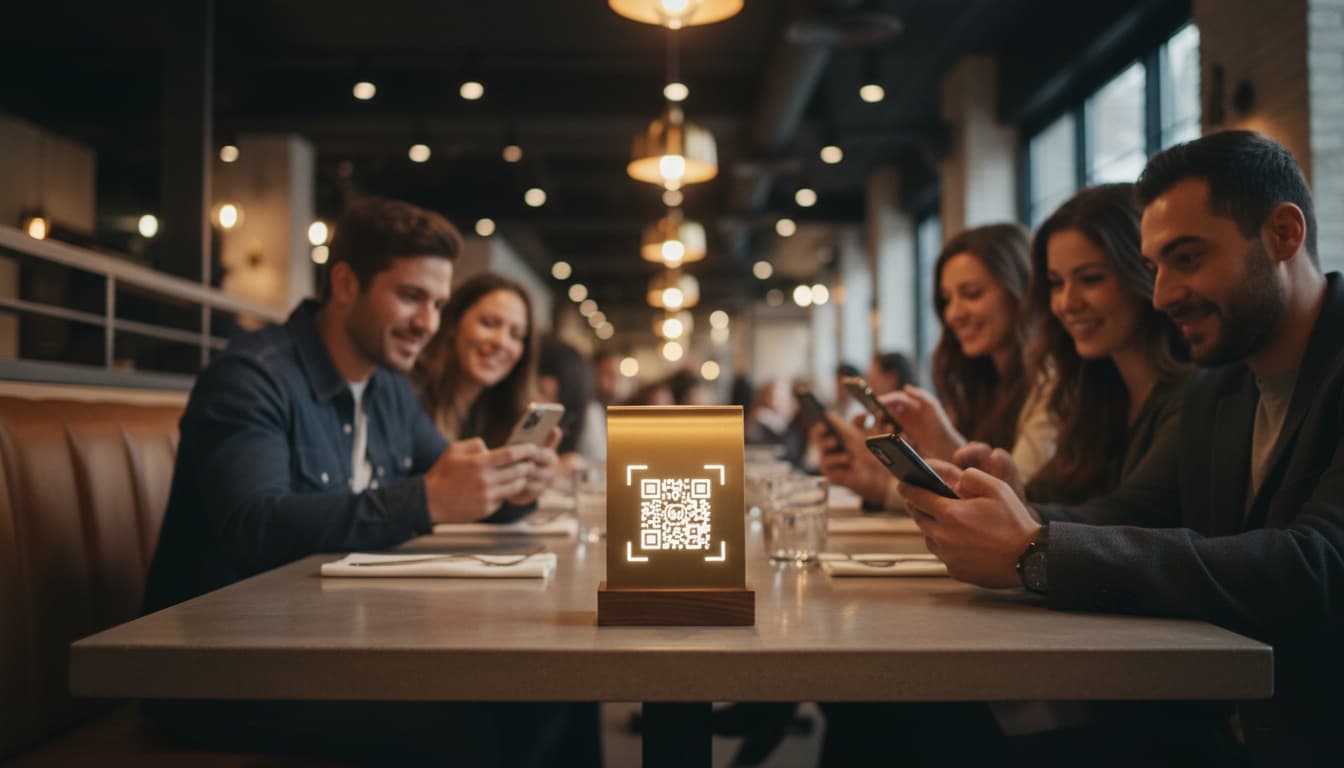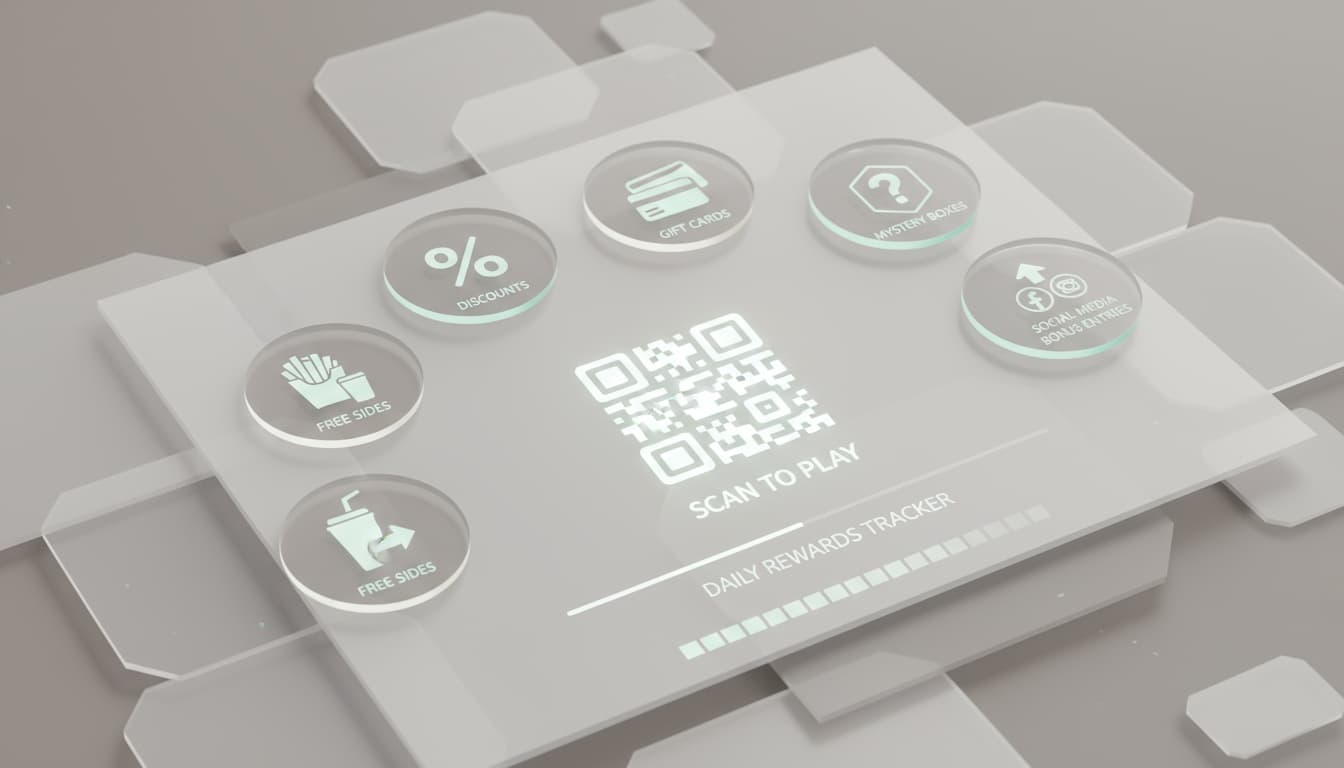The intersection of behavioral psychology, mobile technology, and restaurant marketing created one of the most powerful engagement tools available today: the "Scan & Win" campaign. These gamified experiences use QR codes to transform routine dining interactions into opportunities for acquisition, retention, and revenue optimization. Studies on gamification and personalization consistently show higher engagement, stronger loyalty, and better marketing efficiency when brands design interactive experiences instead of passive promotions.
The best operators understand that "Scan & Win" is much more than a digital giveaway. It is a customer relationship engine that captures behavioral data, drives specific business objectives, and delivers memorable experiences that guests share voluntarily. The key is to apply behavioral economics so that campaigns feel genuinely rewarding while still protecting unit economics and long term profitability.
Modern diners make dozens of micro decisions during a single visit. "Scan & Win" compresses this decision chain by combining instant gratification with clear value propositions. The anticipation of potential rewards activates the brain's reward system, creating positive associations with the brand that extend far beyond the prize itself.
The Strategic Framework: PRIZE Method

Successful "Scan & Win" programs follow a structured framework that aligns guest motivation with business outcomes. A simple way to design them is the PRIZE method.
Purpose Definition
Every campaign needs a clear business purpose. That can be driving off peak visits, increasing average order value, capturing first party data, boosting reviews, or migrating delivery customers to direct channels. Goals determine prize types, mechanics, and where you place QR codes.
Reward Psychology
Prize structures should leverage behavioral economics. Variable reward schedules, near misses, and loss aversion usually outperform fixed rewards. A mix of frequent small wins and rare big prizes keeps participation high because uncertainty makes people return to try again.
Integration Strategy
Scan & Win must fit into existing workflows. Campaigns should integrate with POS, CRM, and marketing tools so that rewards, credits, and data flow automatically. If staff need complicated manual steps to honor prizes, the system will break under real service pressure.
Zero Friction Experience
The journey from scan to reveal should be fast and intuitive. Landing pages need to load in under three seconds on mobile networks. Minimize steps, avoid mandatory app downloads, and show the result immediately after scan with a clear next action.
Engagement Amplification
Strong campaigns include built in sharing mechanics. That can be bonus entries for social posts, friend referrals, or leaderboard style progress. The goal is to extend impact beyond one guest at one table into broader organic reach.
Prize Economics and Expected Value Management
Behind every successful Scan & Win sits a sustainable prize model. The expected cost per scan is the sum of each prize cost multiplied by its probability of winning:
Expected Value = Σ (Prize Cost × Win Probability)Example: suppose you offer a five dollar side with 15 percent win probability, a 20 dollar entree with 2 percent probability, and a 100 dollar gift card with 0.2 percent probability. The expected cost per scan is:
EV = (5 × 0.15) + (20 × 0.02) + (100 × 0.002)
EV = 0.75 + 0.40 + 0.20 = 1.35 dollarsIf the average incremental contribution margin per activated scan is four dollars, this structure remains profitable while still feeling exciting. The goal is to engineer reward curves that feel generous at the guest level while staying safe at the portfolio level.
10 Strategic "Scan & Win" Restaurant Campaign Examples

1. Progressive Jackpot Builder
Objective: sustain engagement and repeat visits while creating social buzz.
Mechanic: a restaurant wide jackpot that grows with every scan until someone wins. Start with a base amount, then add a small amount for each scan across all locations. Show the live jackpot value on table tents, digital displays, and social channels.
Why it works: progressive jackpots tap into near miss and ownership effects. Guests feel they contributed to the pot even when they do not win, and public jackpot growth acts as social proof.
2. Golden Hour Spin Wheel
Objective: fill slow hours without cheapening the brand.
Mechanic: a mobile spin wheel that only works during defined windows, such as weekday afternoons. Prizes include curated items like five dollar flatbreads or two for one espresso that make sense specifically in those time slots.
Execution: gate spin availability by server time, add countdown messages like “Redeem in 60 minutes”, and push via SMS or Stories to nearby subscribers. Over time, this can materially lift RevPASH during targeted windows.
3. Receipt Scan Cashback System
Objective: turn one time diners into repeat guests.
Mechanic: each printed or digital receipt includes a QR code that reveals randomized cashback or credit for the next visit. Access is gated behind consent for email or SMS, and credits expire in a short time frame to pull visits forward.
Advanced twist: inject a quick satisfaction check. Happy guests are routed to public review platforms, while disappointed guests go to an internal form so managers can recover the experience quickly.
4. Social Media Multiplier Contest
Objective: convert guests into active promoters.
Mechanic: after scanning, guests enter a draw where their odds improve as they engage on social media. Sharing a post, tagging friends, or posting original content with a branded hashtag multiplies their entries.
Impact: instead of a one off giveaway, the brand receives a stream of user generated content and sustained social reach that often far exceeds the value of the prizes.
5. Mystery Menu Unlock Experience
Objective: create exclusivity and social conversation.
Mechanic: scanning reveals secret menu items that guests can only order by showing their unlock screen. Items rotate on a weekly schedule and rely on existing ingredients to keep operations manageable.
Why it works: people love feeling like insiders. Secret menus reduce price sensitivity and drive organic word of mouth as guests show off what they unlocked.
6. Beat the Clock Challenges
Objective: reduce ordering hesitation and drive immediate action.
Mechanic: when a guest scans, a timer starts for a specific challenge. Ordering within three minutes might unlock a strong discount during slow periods, while during busy hours the same mechanic can use longer timers and smaller perks.
Psychology: time pressure creates urgency and turns the decision into a simple game instead of an open ended consideration.
7. Delivery Bag Conversion Engine
Objective: migrate third party delivery customers into direct relationships.
Mechanic: every delivery bag includes a Scan & Win card where prizes are tied to direct ordering or dine in visits. For example: “Scan to win free queso when you order direct next time”.
Result: a portion of high fee marketplace orders transition into higher margin direct orders over the next 30 to 60 days.
8. Family Quest Adventure
Objective: win family segments and extend visit duration.
Mechanic: a three stop quest inside the restaurant. Families scan the first QR to start, then follow simple clues to murals, dessert cases, or host stands. Completion unlocks kids desserts or small rewards during specific family hours.
Benefit: children stay engaged, parents experience a smoother meal, and the brand becomes the default choice for future family occasions.
9. Skill Based Trivia Challenges
Objective: deepen engagement while gathering insight.
Mechanic: QR codes launch short trivia games about the menu, brand story, or local themes. Performance determines prize tiers or bonus entries.
Data angle: responses reveal item awareness, preference clusters, and brand knowledge that can inform product, marketing, and content decisions.
10. Seasonal Advent Calendar
Objective: build daily habits and prolonged engagement.
Mechanic: a calendar style campaign where each day over a month unlocks a new offer or experience when guests scan. Catch up mechanics let them claim missed days within a limited window so one slip does not end participation.
Use cases: holiday seasons, summer patio campaigns, or back to school periods where the restaurant wants recurring contact rather than one large event.
Implementation Strategy and Technology Requirements
To execute Scan & Win reliably across real service conditions, technology and workflow matter as much as the game idea itself.
- Dynamic QR platform: always use dynamic codes so you can change content, test variants, and see analytics without reprinting.
- Mobile first landing pages: sub three second load times, compressed assets, and layouts designed for thumbs, not desktop mice.
- Integration with POS and CRM: rewards should apply automatically to checks where possible, and captured data should flow into segmented lists.
- Security practices: branded HTTPS domains, tamper evident stickers or fixtures, and weekly audits to prevent malicious QR swaps.
Legal Compliance and Risk Management
Because Scan & Win mechanics can resemble contests or sweepstakes, compliance is not optional.
- Promotional rules: many markets require a "no purchase necessary" path, clear odds, start and end dates, and eligibility statements for prize draws.
- Data privacy: use explicit consent for email and SMS, with double opt in for SMS and easy unsubscribe to comply with local regulations.
- Prize limits: check local rules around maximum prize values or frequency to avoid accidentally crossing into regulated gaming territory.
Performance Measurement and ROI Analysis
To justify continued investment, campaigns need a simple but disciplined measurement framework. Core metrics include scan rate, conversion to the desired action, incremental revenue per participant, and lifetime value impact for guests added to your database.
A basic ROI model for a Scan & Win campaign can be written as:
Campaign ROI = ((Incremental Revenue + Marketing Value - Prize Costs - Implementation Costs) / Total Investment) × 100Marketing value includes the equivalent media value of social impressions, user generated content, and database growth. Strong campaigns often reach three to five times return on total investment within one or two months when both direct revenue and marketing value are counted.
Common Implementation Pitfalls and Solutions
Static QR Codes Without Analytics
Risk: you cannot adjust or measure campaigns, so learnings stay superficial.
Fix: shift to a dynamic platform with dashboards, A/B testing, and per placement tracking.
Broken Mobile Experience
Risk: slow or clumsy pages destroy trust and cause abandonment.
Fix: test on real devices and networks, keep designs light, and remove unnecessary fields before launch.
Too Many Codes and Confusing Choices
Risk: guests do not know which QR to scan or why.
Fix: use the "one code, one job" rule. If you need multiple paths, route from one main QR into a simple hub page.
Undertrained Staff
Risk: even well designed campaigns fail if staff cannot explain or support them.
Fix: include Scan & Win walkthroughs in pre shift meetings, arm staff with simple scripts, and show them how campaigns impact tips and traffic.
Advanced Optimization Strategies
Once the basics work, more advanced operators layer personalization, pricing strategy, and external triggers on top of their Scan & Win engine.
- Personalization: use purchase and engagement history to tailor prize probabilities and offers to each guest profile.
- Dynamic pricing: adjust reward intensity by daypart and weekday so that incentives are strongest where you most need volume.
- Weather and event triggers: connect campaigns to weather APIs or local event calendars so that rain, heat waves, or stadium schedules automatically activate the most relevant offers.
When Scan & Win is engineered this way, it becomes a permanent component of the restaurant's growth system rather than a one off stunt. The restaurants that master these gamified experiences build deeper relationships, capture better data, and turn everyday visits into repeatable, memorable wins for both guests and the business.
Launch Smart Scan & Win Campaigns With VISU
Use VISU to run dynamic Scan & Win campaigns with QR codes, real time rewards, and data rich tracking that connects every scan to measurable restaurant results.

